There is only one way to survive this market. Focus on strength. Ignore the intraday volatility. And always expect the unexpected.
The stock market remains in a stubborn trading pattern, with nearly equal measures of strength and relative weakness. On the one hand, many hedge funds remain short stocks. Their short-term options related plays create intraday volatility and perpetuate a general feeling of uncertainty.
On the other hand, value players are moving into certain sectors, especially after short-term bear raids knock them down. Their steady buying counters the hedge funds' short-term trades, often creating intraday rallies. In between are bond traders betting on recession.
Combined, these influences are creating a frustrating narrow trading range with unpredictable intraday swings. Yet, as the Fed continues to talk tough on inflation and rate hike odds rose late in the week, in the real world, the economy is already showing signs of slowing. CPI is flattening, PPI may be rolling over, retail sales are slowing, commercial real estate is in trouble, and layoffs and joblessness claims are rising.
The Fed is Playing with Fire
The Fed is playing with fire as it plans for an almost certain 25-basis-point rate increase in the Fed Funds rate at its May 2-3 FOMC meeting.
Last week, in this space, I expressed concern about the unexpected decrease in jobs created by the private sector in the Southern region of the U.S. Here is a reprise of the regional ADP new-jobs-created numbers:
- Northeast: 141,000
- Midwest: 132,000
- West: 95,000
- South: (-) 228,000
As I noted then, these numbers reflect a slowing in new job creations, with the reduction in the South sounding the alarm.
I also noted that the Challenger Jobs Cut report and weekly jobs claim data from the Bureau of Labor Statistics (weekly jobless claims) were starting to suggest more weakness may lie ahead. Specifically, I noted that Challenger had reported 89,000+ job cuts for March, 270,000+ for the year. The West Coast was the biggest contributor. Here is the breakdown of Challenger's numbers:
- East: 13,638
- Midwest: 21,764
- West: 48,123
- South: 6,178
In conclusion:
- New job listings are falling;
- New job creation is stalling;
- Layoffs are increasing; and
- The number of people requesting unemployment insurance is on the rise.
What could possibly go wrong when the Fed raises rates in May?
Mortgage Activity Picks Up as Rates Fall; Watch Support Area for Homebuilders
The recent decline in bond yields, notwithstanding the reversal on 4/15/23 in response to hawkish Fed talk, has turned the housing market into a haven for interest rate stalkers. Every time bond yields fall, potential home buyers who are on the fence pounce on the lower rates. Over time, this will continue to fuel the bullish trend for homebuilders, especially in the Southern U.S. In the present, however, the bond market continues to bet on a recession as yields test the 3.5% area.
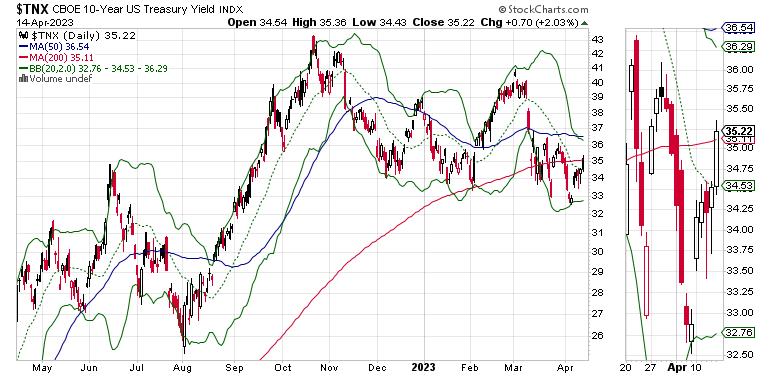
If the bond market is correct, the U.S. economy is heading for recession and the Federal Reserve will be pressed to lower interest rates. The Fed meets on May 2-3 and is now expected to raise rates 25 basis points. That is likely to increase volatility in bond yields.
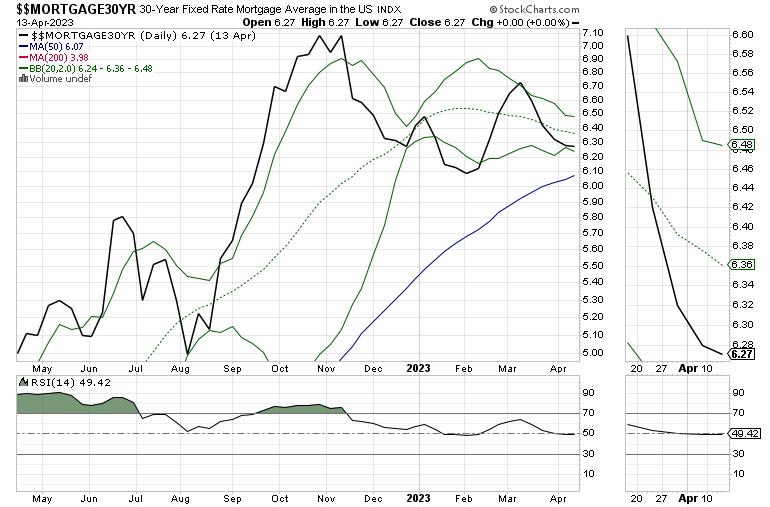
Mortgage rates fell for the fifth straight week, following historical norms as the multi-year view of the relationship between bond yields (TNX) and mortgage rates (MORTGAGE) shows. Normally, this bullish scenario is also a positive for the price action in the Homebuilders Subsector Index (SPHB).
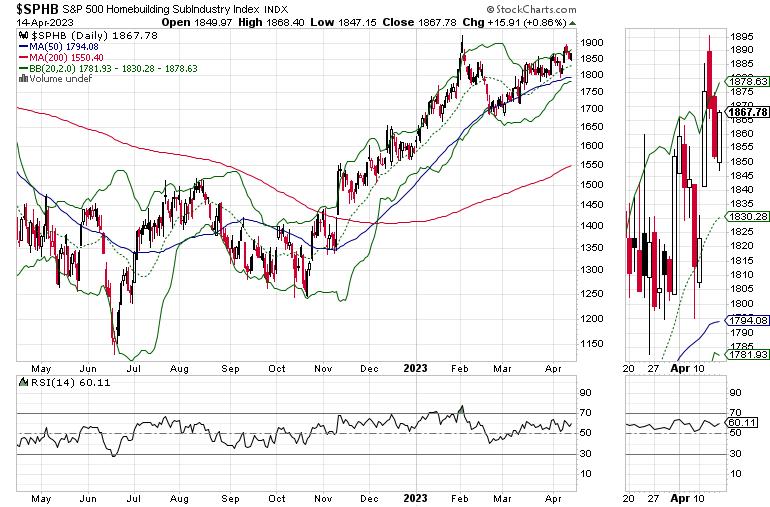
For now, however, the homebuilder sector remains in a consolidation pattern as traders await more definitive direction from the Fed on interest rates. Another Fed rate hike, which is possible at its May 2-3 FOMC meeting, would once again put a damper on mortgage rates and the stock market, including the homebuilders.
On the other hand, given what we're seeing in relationship to bond yields and mortgage rates, a pause would likely boost homebuilder stocks. For now, the consolidation pattern is SPHB is not necessarily a sign of alarm, although a move below 1800 (the 50-day moving average) would be a very bearish development for the sector.
To view my homebuilder picks and how I'm trading the bond market, click here. For an in-depth comprehensive outlook on the homebuilder sector, click here.
Focusing on Strength
Investors with positions in the right sectors are outperforming the market. Here are two examples of what's working and what's not.
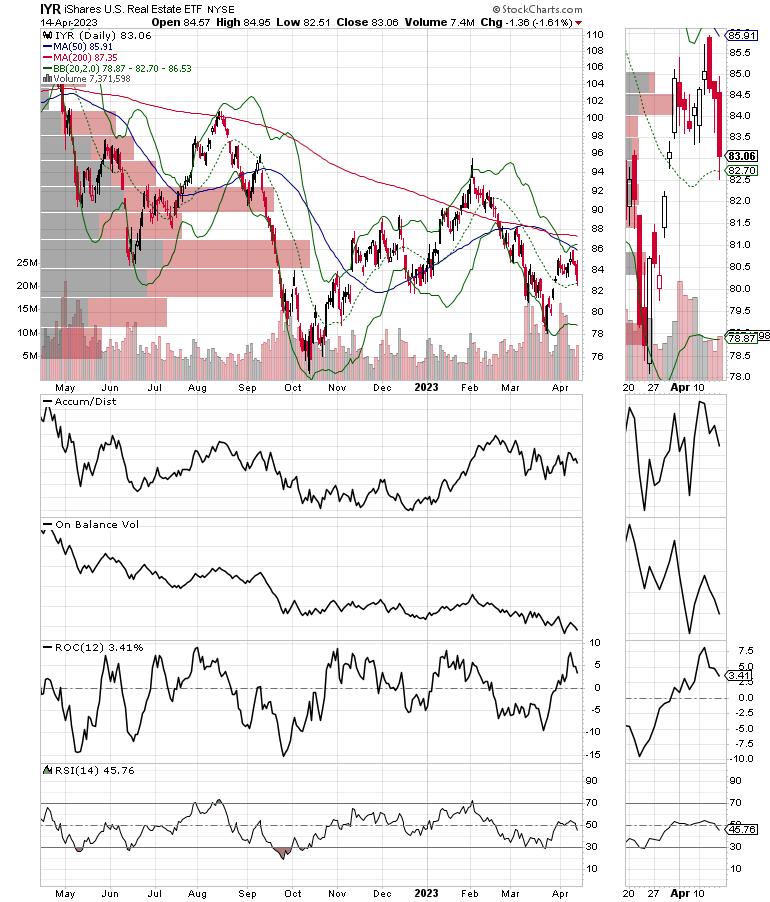
Commercial real estate is struggling. This is especially affecting the technology-rich areas of Silicon Valley and Austin, Texas, where vacancy rates are rising. Moreover, a negative divergence is developing between bond yields and real estate investment trusts.
Normally, lower bond yields are bullish for real estate investment trusts (REITs). But because of the office bust in the tech sector, loan defaults are piling up, vacancy rates are rising, and we're just not seeing any signs of life in the REITs. You can see the action in the iShares U.S. Real Estate ETF (IYR) as it struggles below its 200-day moving average. That's a sign that investors are bracing for even worse circumstances.
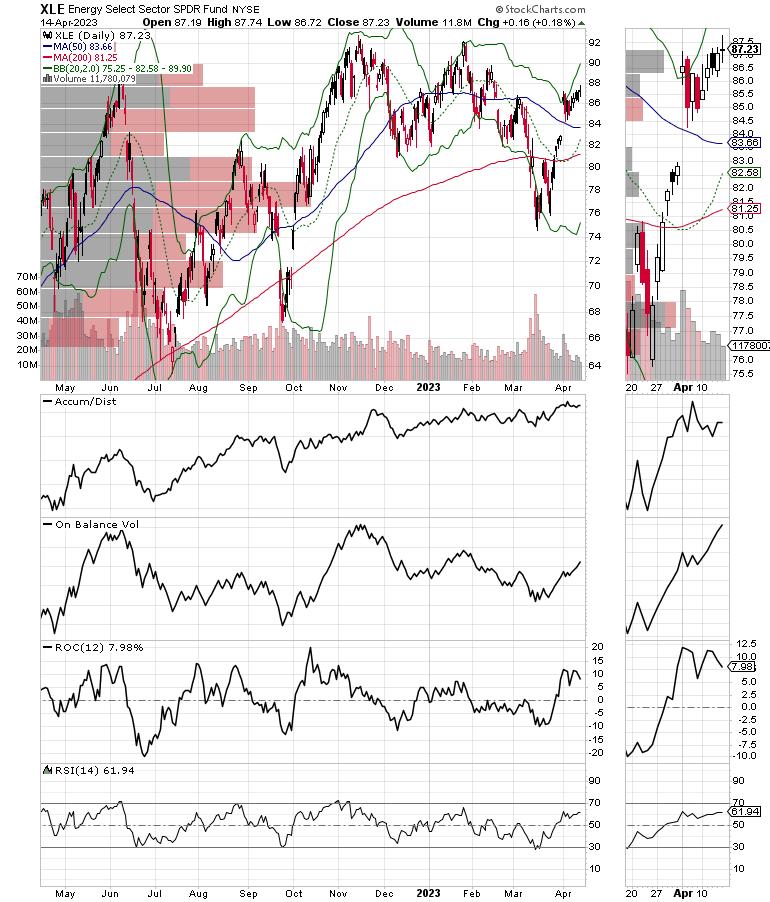
On the other hand, the oil stocks are attracting money. You can see the steady accumulation pattern in the Energy Select Sector SPDR ETF (XLE). Especially bullish is the recent uptick in On Balance Volume (OBV), which signals that buyers are building positions. A move above $90 would likely attract more money into XLE as momentum players begin to crowd in.
I recently recommended two energy options trades, which you can access with a FREE trial to Joe Duarte in the Money Options.com. In addition, I just wrote a comprehensive report on the oil market, which is available FREE of charge to members at my Buy me a Coffee page.
Breadth Holds Steady, Nasdaq Again Holds 13,000
Although prices gyrated wildly in a narrow range last week, the market's breadth held up. Once again, the New York Stock Exchange Advance Decline line (NYAD) closed above its 50-day moving average and its long-term support line, the 200-day moving average. This is a positive.
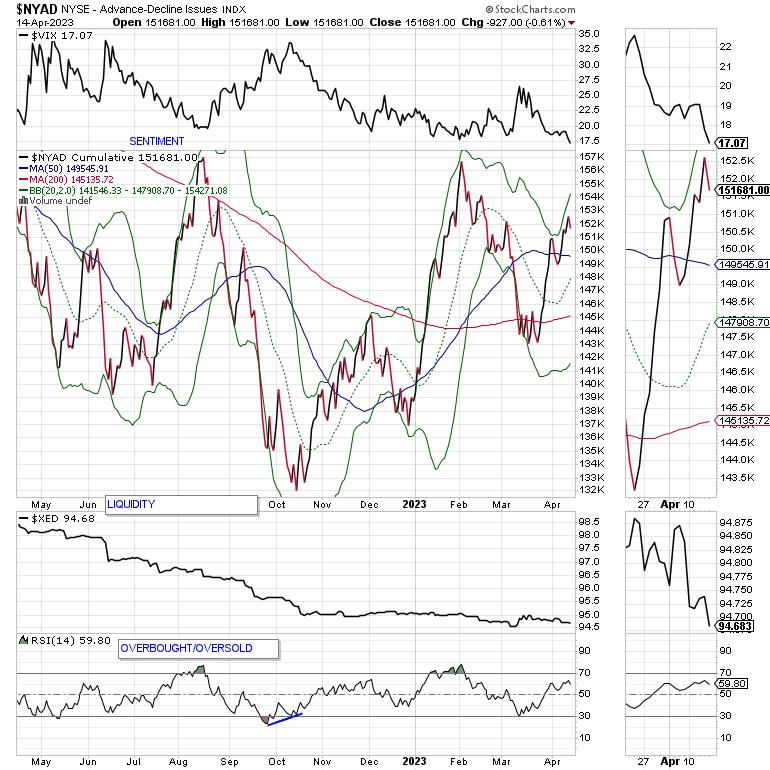
The S&P 500 (SPX) also held up, despite short-term volatility closing above 4100. 4100-4200 is still an important resistance band. On Balance Volume (OBV) and Accumulation Distribution (ADI) remained constructive.
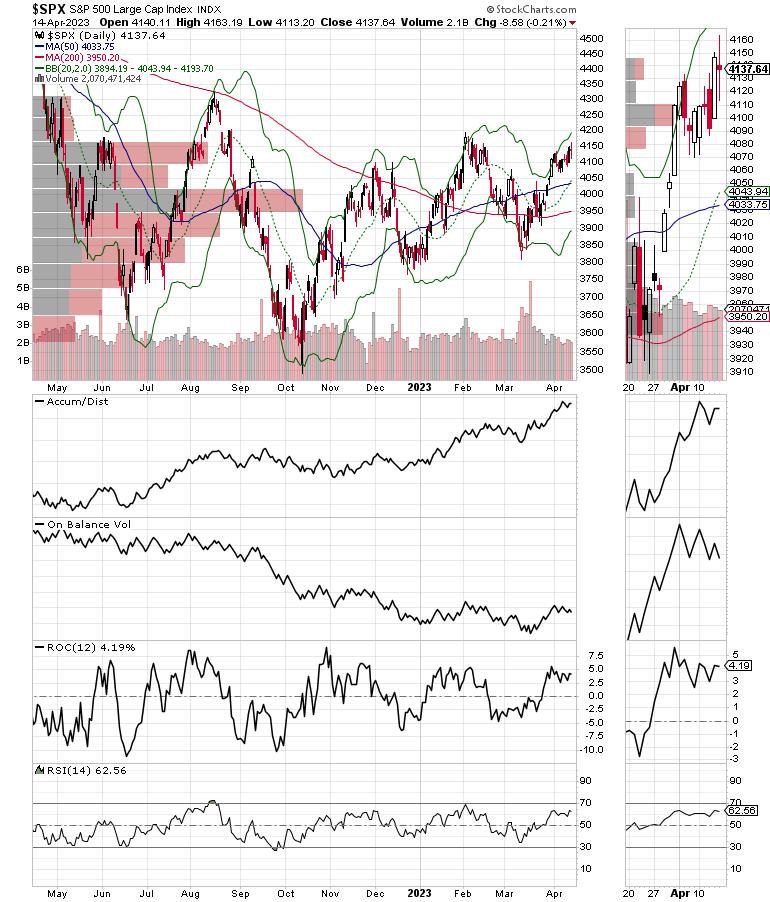
For its part, the Nasdaq 100 Index (NDX) also held above the important 13,000 area, which has becomes fairly reliable support. This remains bullish as it suggests money is now pouring into technology stocks. When tech stocks rally, they give the whole market a boost. Accumulation Distribution (ADI) and On Balance Volume (OBV) are very bullish for NDX.
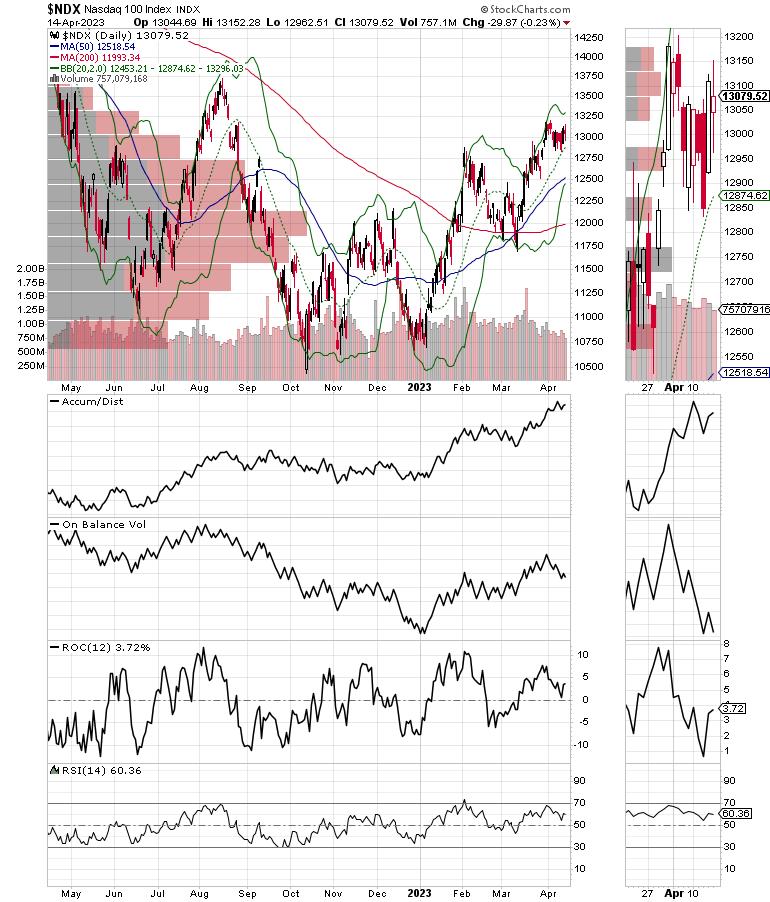
The CBOE Volatility Index (VIX) broke to a new low and is now well below 20, a sign that the bears are throwing in the towel. This is also bullish.
When VIX rises, stocks tend to fall, as rising put volume is a sign that market makers are selling stock index futures in order to hedge their put sales to the public. A fall in VIX is bullish, as it means less put option buying, and it eventually leads to call buying, which causes market makers to hedge by buying stock index futures. This raises the odds of higher stock prices.
The market's liquidity retreated as the Eurodollar Index (XED) closed slightly below 94.75 on Fed hike expectations. A move above 95 will be a bullish development for sure. Usually, a stable or rising XED is very bullish for stocks. On the other hand, in the current environment, it's more of a sign that fear is rising and investors are raising cash.
To get the latest up-to-date information on options trading, check out Options Trading for Dummies, now in its 4th Edition—Get Your Copy Now! Now also available in Audible audiobook format!
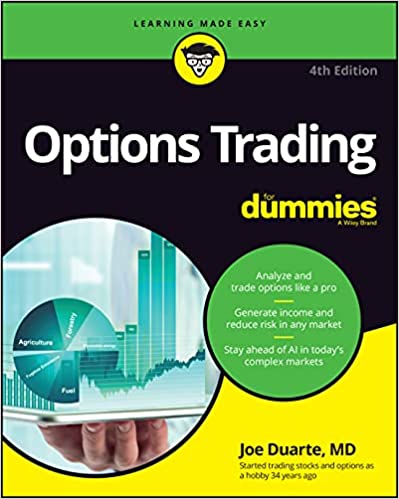 #1 New Release on Options Trading!
#1 New Release on Options Trading!
Good news! I've made my NYAD-Complexity - Chaos chart (featured on my YD5 videos) and a few other favorites public. You can find them here.
Joe Duarte
In The Money Options
Joe Duarte is a former money manager, an active trader, and a widely recognized independent stock market analyst since 1987. He is author of eight investment books, including the best-selling Trading Options for Dummies, rated a TOP Options Book for 2018 by Benzinga.com and now in its third edition, plus The Everything Investing in Your 20s and 30s Book and six other trading books.
The Everything Investing in Your 20s and 30s Book is available at Amazon and Barnes and Noble. It has also been recommended as a Washington Post Color of Money Book of the Month.
To receive Joe's exclusive stock, option and ETF recommendations, in your mailbox every week visit https://joeduarteinthemoneyoptions.com/secure/order_email.asp.
